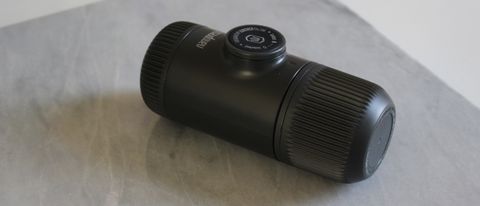TechRadar Verdict
Impressively good espresso from a hand-powered machine? Wacaco’s Nanopresso proves the naysayers wrong.
Pros
- +
Great tasting coffee
- +
Espresso on the go
Cons
- -
Requires focus
- -
Boiling water required
Why you can trust TechRadar
The Wacaco Nanopresso is certainly a bit of a wild card: a hand-powered machine resembling a souped-up Thermos probably isn’t what you had in mind when setting out to buy an at-home espresso maker. But we were so impressed by Wacaco’s Nanopresso charms that we couldn’t resist including it.
Simply put, the Wacaco’s Nanopresso is a pocket-sized machine with the ability to brew hand-pumped espresso. Whether you’re not able to entertain a blimp-sized domestic espresso machine or just on the go so much that home means more than one place, the Nanopresso is a surprisingly worthy contender.
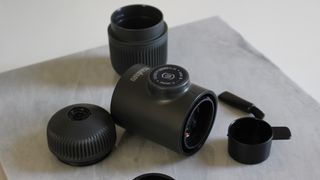
Design
The first thing you need to know about the Nanopresso is there’s no battery or charging. Your espresso is created with up to 18 bars of pressure through hand-pumping, and the end result is comparable to what you’d be served in a cafe.
Lighter, smaller, easier to pump and yet twice as powerful as its predecessor (the Minipresso), the Nanopresso comes with a built-in espresso cup and lightweight case that’s moulded perfectly to house the device.
You can even use the bottom of the coffee scoop to tamp down your grinds, and if you’re a pod convert, pick up an NS Adapter from Wacoco so you just travel with pods instead.
Although the Nanopresso’s body and components are made from plastic, it feels very solid and robust, and ideal for traveling. Little touches, like the fact the screw thread for the water container just presses on and off, make the Nanopresso feel like it would last a good few years on the road.
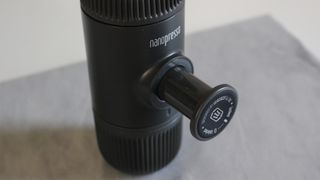
Day-to-day use
If you’ve never used an outdoor espresso maker before, it takes a bit of time to work out what each component is for, so this is definitely not one to try for the first time at 7am on a weekday morning, but it’s great for taking high quality espresso with you no matter where you're going.
Over a month of use, we found this best for nomadic working and weekends away - in other words, all those times when you’re not sure if there’s going to be great espresso within easy reach.
If you’re on the road a lot, studying in libraries or merely changing offices regularly throughout the day, the Nanopresso was a neat gadget that’s used with minimal fuss. All you need is access to hot water and some kind of stable surface to set everything up.
The only downside we really noticed would be the same as having a vacuum flask with you, which is the drying time and re-assembling all the components back - but with such great tasting coffee, it’s a negative that’s easily outweighed by the positives.
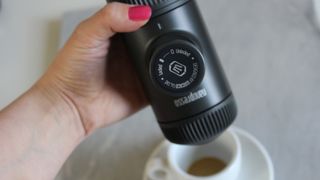
Taste
After a few attempts, we were achieving gorgeously smooth, rich cremas with every shot, thanks to those 18 bars of pressure forcing hot water through the coffee grinds.
In fact, we feel like it’s precisely because this machine is so simple and the technology is boiled right down to the essentials, that it’s easy to tweak and see immediate results. Within a few days, you do feel like you’re learning a lot about honing in on that perfect espresso.
The fact Wacaco’s patented pressure system can achieve that 18 bar pressure is a serious game-changer for hand-powered espresso, and it means the Nanopresso is able to compete in flavor against the top end of the market.
If you’re into add-ons, Wacaco has also released a Barista Kit Double Espresso that we also experimented with whilst reviewing. The Barista Kit screws on to the Nanopresso to enable it to make two shots of espresso, although it means bringing another barrel of kit along - we preferred the stripped-back design of the Nanopresso for convenience.

Eco
The eco credentials of this small machine are impressive. From the off, the Nanopresso only requires you to boil water - the rest is done by hand.
What’s more, because it is so portable, if you’re looking to cut down on takeaway coffees (and all the disposable packaging that comes with them), the Nanopresso involves a lot less waste and money, and with a (comparatively) low initial spend anyway, it’ll only be a month or so before you’ve saved back the spend on a daily coffee habit.
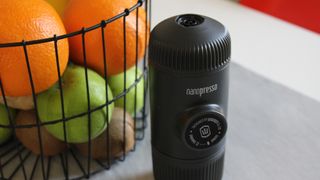
Verdict
In look, price, and experience, the Nanopresso couldn’t be further than the top of the range espresso machines we’ve reviewed. And yet the taste is almost on par. It is more of a faff, it does involve boiling water and finding a flat spot if you’re outside, but the end result is seriously impressive.
It’s incredibly practical, has a low eco impact and it doesn’t require you to pay into a specific system - switch between pods or grinds, and forget about cleaning products all together - just old fashioned soap and water will do the trick.
After a month with the Nanopresso, it was the democratic nature of the thing that most impressed us. Whether you’re in a college cafeteria, a campsite or an under-equipped co-working space, the Nanopresso enables you to make flawless espresso by hand, using no electricity.
It’s far from a plug-in-and-go job, but the Nanopresso actually had us asking why coffee had become so complicated, when all you really need for a wake-up call is a small and mighty piece of kit like this.
- Find the best coffee makers
Ava Szajna-Hopgood is a freelance writer and marketing and communication specialist with a passion for the creative industries. She worked as Features Editor for Urban Junkies for two years writing weekly trends, restaurant reviews and travel guides.
